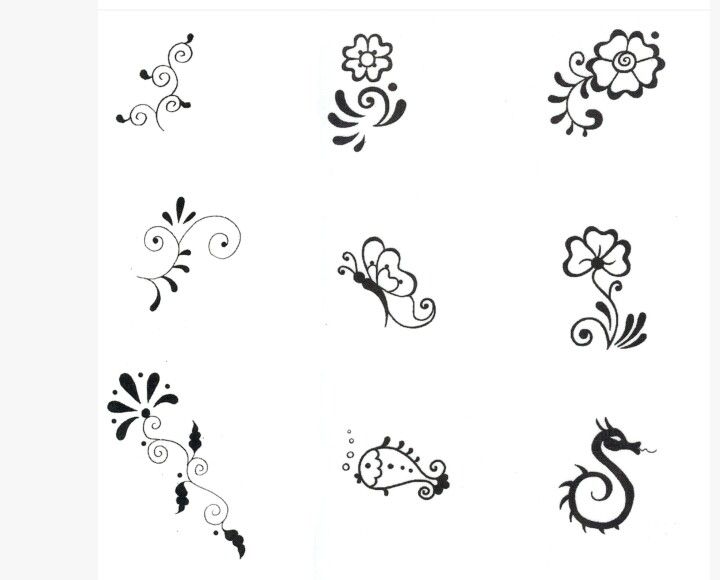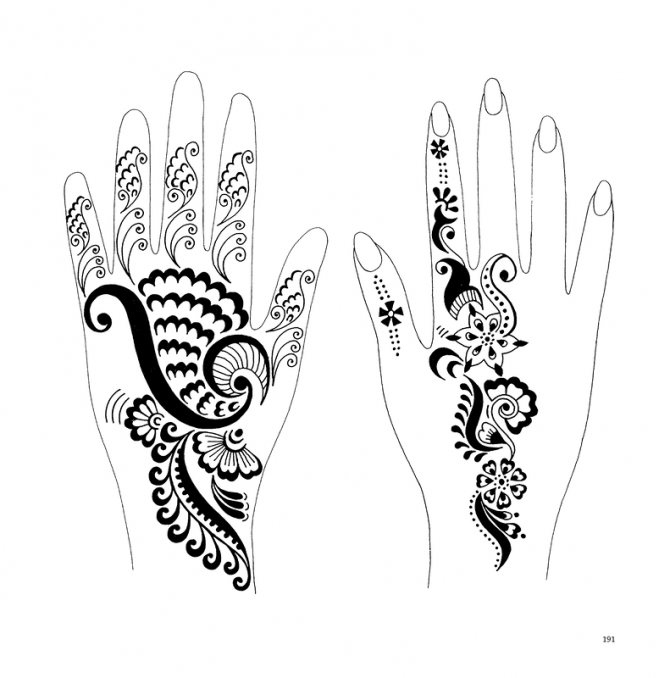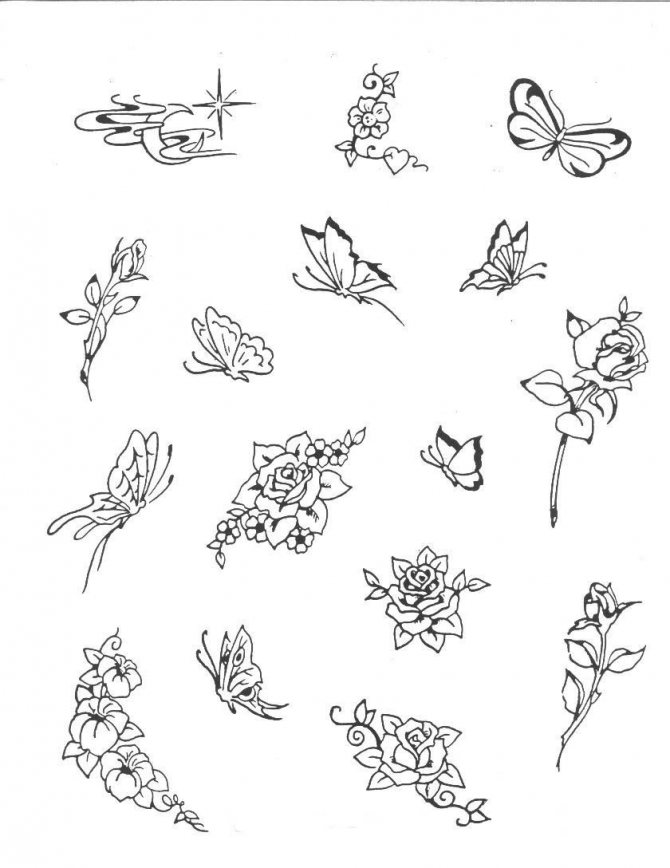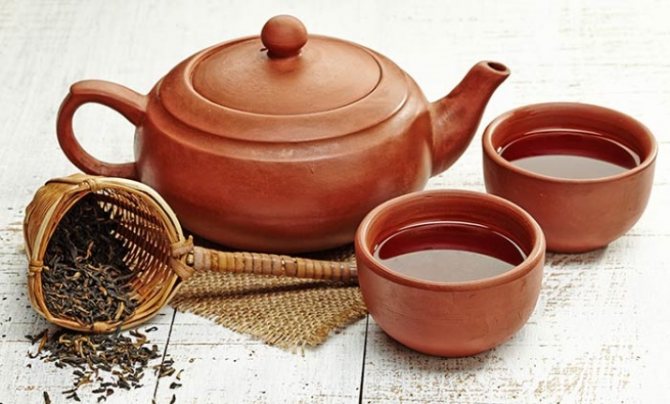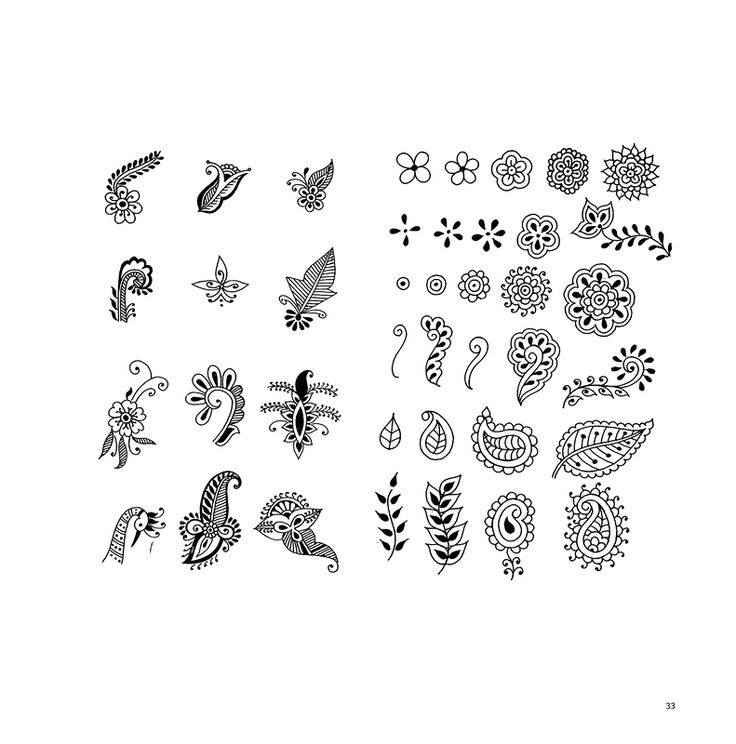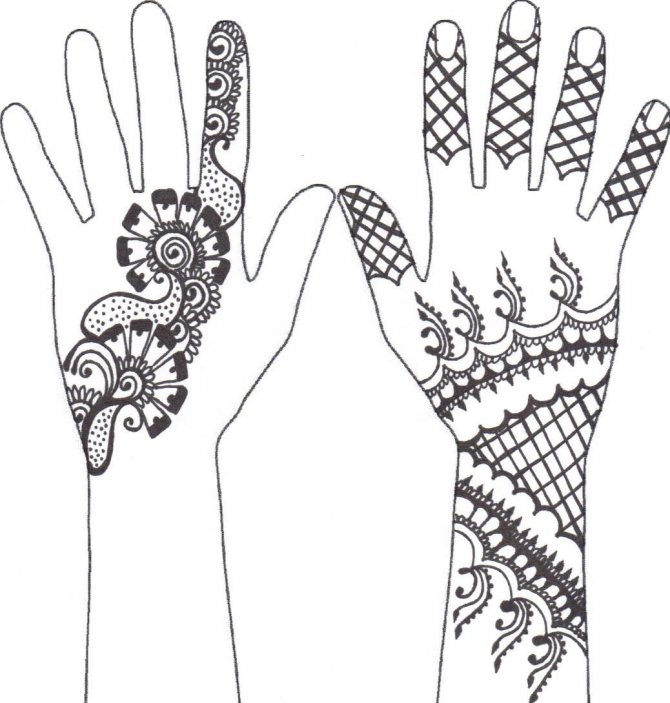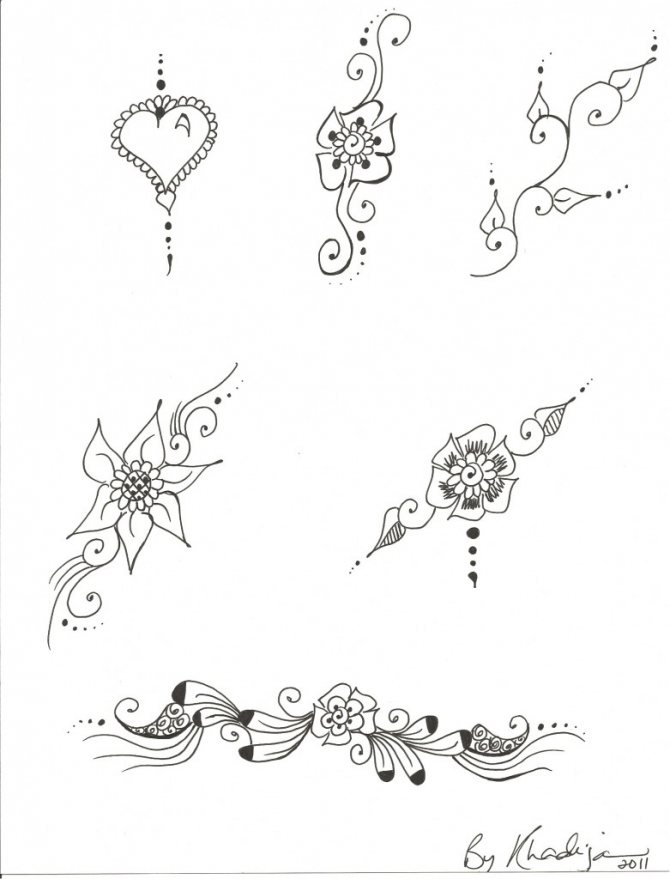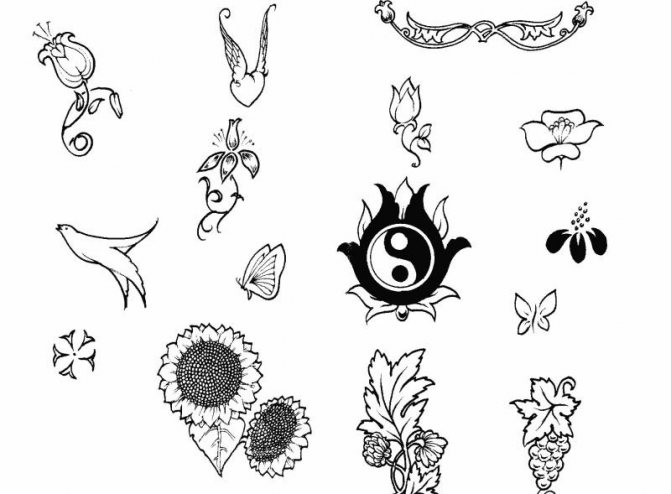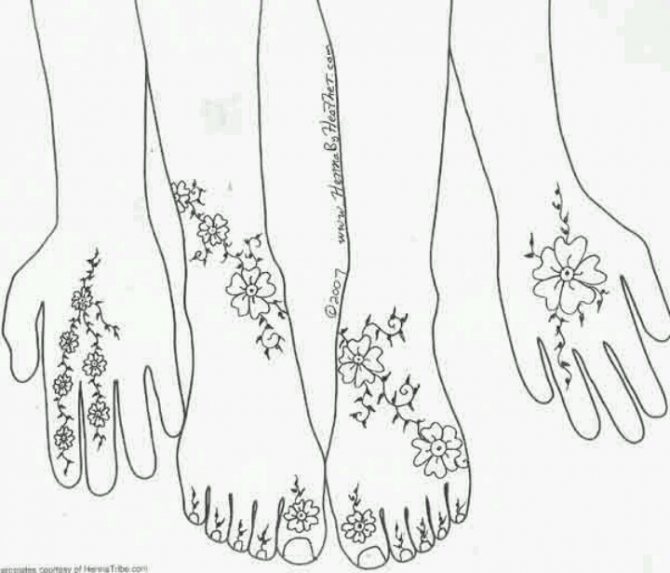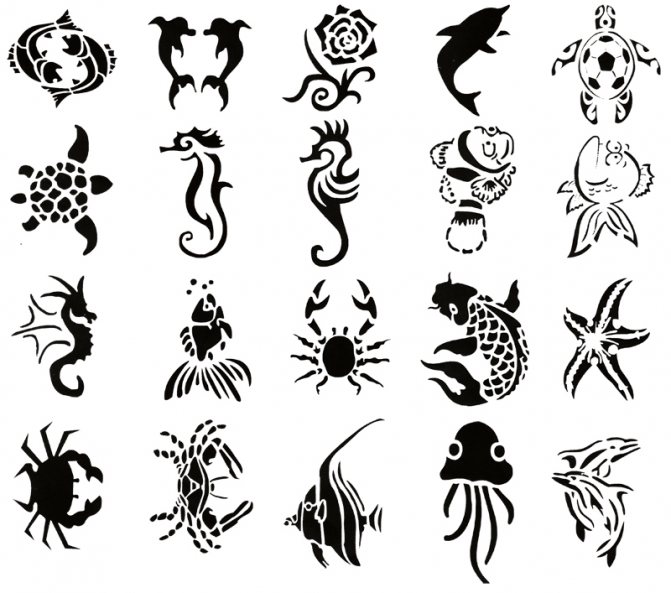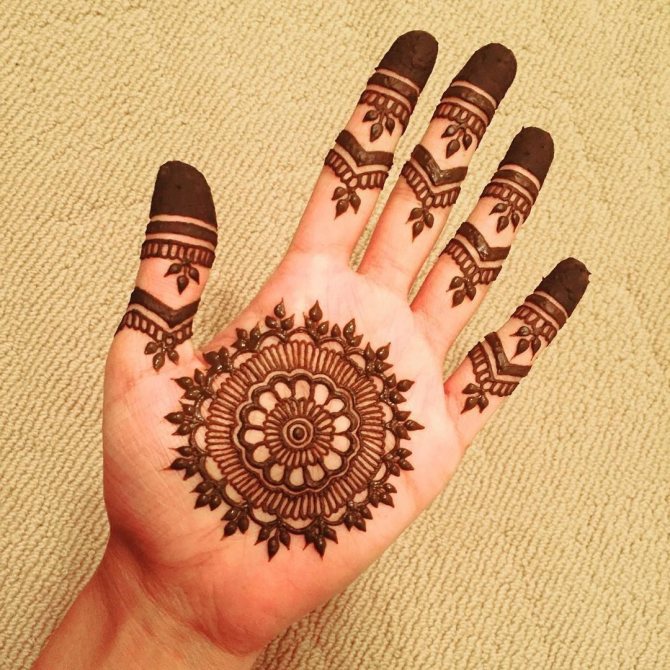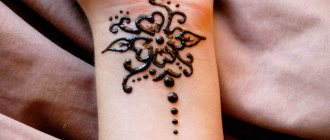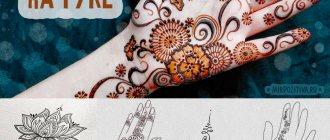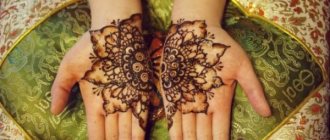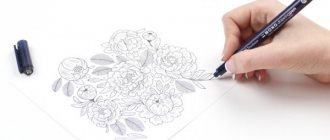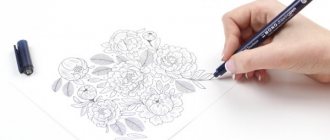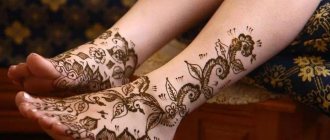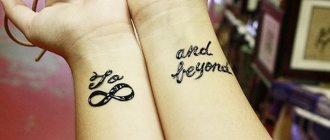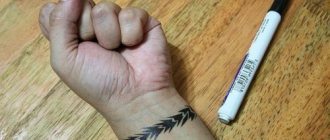How to choose a henna?
Henna for mehendi is sold in two forms: powder and paste. The paste is great for beginners, the powder is more difficult to work with. To use a dry product, you need to know exactly the rules of dilution, the necessary components and their proportions. The paste product is often sold in cones. To use it, you just need to carefully cut off the tip and squeeze out the product.
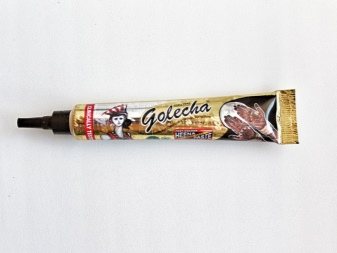
When choosing a material, it is important to understand its composition and origin. There are two kinds of henna for mendi:
Natural. Such a natural dye is obtained from the leaves of the cinnamon tree. The color of the natural product is brown
If you buy pasta in a cone, pay attention to its appearance. If you notice that the packaging is deflated or deformed, then there is a low-quality product inside
In addition, the packaging must be carefully sealed, without holes. This is due to the fact that the product can solidify. The paste itself has a fluid and soft structure.


The freshness of the henna and the saturation of the color are fundamental. The freshness of the material determines its ability to color the skin. You can't be sure that the seller has followed the rules of storage of the material, but you can definitely check the expiration date before you buy it.
Natural henna is good for one year. However, you can only get a really good shade in the first 3 months if you follow the storage rules, then the color will fade
That's why it's important to ask the seller for the date of manufacture, not the expiration date. If you can examine the box of the product, take advantage of it.
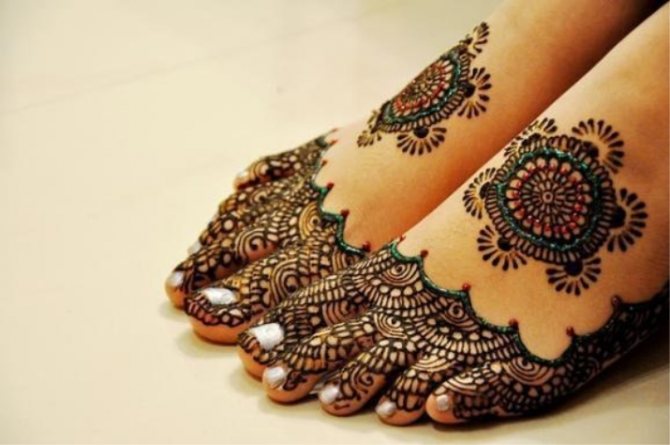

Good quality henna can be distinguished by the following signs:
- The cone is plump and impossible to squeeze with your fingers.
- Once you open the package, you see a pourable and soft paste.
- The henna spontaneously leaks from the package after opening it.
All of these freshness recommendations apply specifically to natural henna. Black and colored has chemical elements in its composition, so it retains its freshness longer. The color of the dye depends largely on the original skin tone. Natural brown dye on light skin can take on an orange color. Keep these nuances in mind when choosing materials.
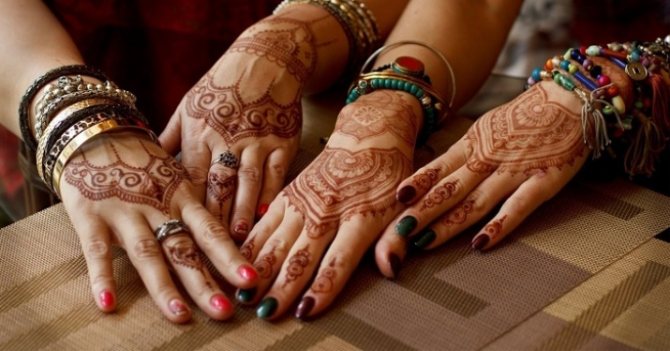

Meaning of the symbols in mehendi drawings
The art of drawing henna on the body has its roots in the distant past and is closely associated with the beliefs of eastern peoples. Geometric ornaments, floral patterns, images of animals painted on the body served as a kind of amulets. Therefore, it is not surprising that the elements of mehendi are deeply symbolic and can contain secret messages, understandable to those who can "read" them.
Here is what the most popular symbols in mehendi mean:
- Peacock - beauty;
- Swan - success;
- Bird - messenger between heaven and earth;
- Butterfly - changes to come;
- Parrot - ambassador of love;
- Dragonfly - renewal, rebirth;
- Fish - women's eyes;
- Scorpio - love and romance;
- Elephant - greatness, prosperity;
- Flower - joy and happiness;
- Leaves and vines - longevity, loyalty, vitality;
- Turtle - protection and fertility;
- Snake - enlightenment;
- Ivy - financial well-being;
- Flowering lotus - beauty, grace, sensuality, purity, femininity;
- Sun, moon and stars - lasting deep feelings between two committed partners;
- Cucumber - wealth and good luck;
- A bud, a bud - the beginning of a new life (usually after a wedding);
- The ripple - water, which cleanses and brings new life;
- Square - healing from illnesses;
- Triangle - protection of body and spirit;
- Circle - stability in life;
How to learn how to draw mehendi henna on the body - photo and video
Before you learn how to draw mehendi, you should choose the appropriate ornaments. There are several varieties of ornaments that are used in henna body painting:
- Arabic - floral patterns;
- African - dominated by geometric shapes;
- Indian - lines and dots.
How to learn how to draw mehendi henna on the body without damaging your appearance? It is best if you first draw the drawing on a sheet of paper and then transfer it to the skin. You can use a ready-made sketch by printing it out on a printer. If you find it difficult to sketch an ornament, sketch directly on your skin with a cosmetic pencil, and apply paste directly along the lines. When the paste has dried and its excesses have been removed, it is easy to remove the traces from the soft pencil. If you are completely unsure of your artistic abilities, use stencils. Simply apply the stencil to the chosen area of the body, fix it with tape and apply henna to the entire surface of the stencil, where there are slits.
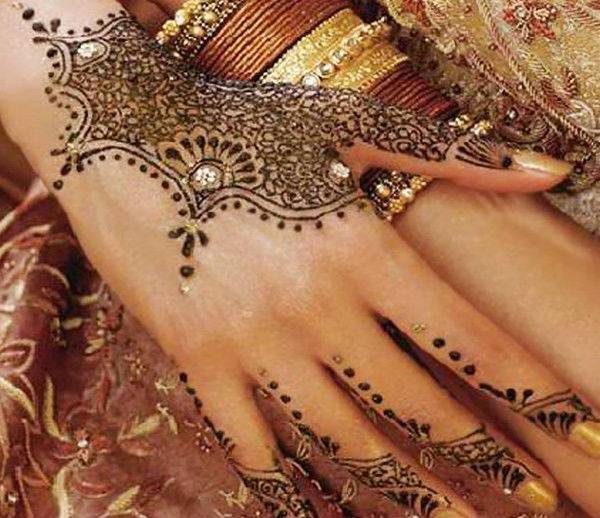

The photo, how to draw mehendi, shows us that mainly the patterns cover the hands and feet, often the ornaments reach up to the elbows on the hands and knees on the feet. However, modern fashionistas decorate the most diverse parts of the body with these biotattoos. This is not surprising - temporary tattoos are much more in demand among young people, besides it is safe, the skin is not damaged by needles, and the paste composition is entirely natural. Not only that - henna even has medicinal properties. If you don't quite understand how to draw mehendi henna, the video will answer your questions and show you how to apply the luxurious ornaments correctly:
Now you know how to draw mehendi on the body, and you can safely show off mind-blowing images, without harming the skin and impressing others with an unusual appearance.
You can use a ready-made sketch by printing it out on a printer. If you find it difficult to sketch an ornament, make a sketch directly on the skin with a cosmetic pencil, and apply paste directly along the lines. When the paste has dried and its excesses have been removed, it will not be difficult to remove the traces from the soft pencil. If you are at all unsure of your artistic skills, use stencils. Simply apply the stencil to the chosen area of the body, fix it with tape and apply the henna all over the surface of the stencil where there are slits.
What you need for henna painting: a mini overview for beginners
Initially, you'll need to buy paste for painting.
Where to find paste for mehendi
Such paste is sold in mehendi drawing salons. You can also find it in Indian shops and at Indian exhibitions that take place every year in all major cities.
Composition of henna paste
If you decide to buy such a paste, then pay attention to the composition. Besides henna and lemon juice there should not be other dyes and preservatives!!!
Most often it is sold in small cone-shaped bags. It should have a shelf life of no more than three months.. Otherwise you will be in a bad mood, and manifested rash instead of the desired pattern ... With which, incidentally, you also run the risk of one to three weeks ...
However, to properly draw henna on the hand, it is not necessary to buy ready-made paste. You can make it yourself. There are several effective (eco-friendly and safe!!!) recipes, which we will share with you now.
Why several? Because the classic process of making dye paste is long enough. It takes at least 24 hours. And there is a simplified recipe that is ideal for all impatient and hurried girls, girls, women ... To all, in short
Tattoo henna: the main advantages
Despite the popularity of such temporary tattoos, many people still doubt whether it is worth doing such an option. In fact, this material has a lot of advantages. At a minimum, with his help, you can make absolutely any design on your own, even without turning to a master. This significantly saves time and finances.
In addition, it should be noted that the application of the henna tattoo is absolutely painless, which can not be said about the classic version
The process of application itself is safe, which is also important. For many students and schoolchildren the indisputable advantage of course is the cost
It is dozens of times lower, so make such a tattoo can absolutely everyone.
Now we came to the advantages of mehendi:
- It is a temporary tattoo that will not have time to get bored. If you want, you can try different variations of patterns and surprise those around you.
- Because henna is a natural hypoallergenic substance, mehendi will not bring any harm, will not cause irritation and redness on the skin.
- You can skilfully hide scars, pigment spots and other skin imperfections with the help of skilful ornaments.
- The process of applying mehendi does not cause any discomfort and pain. You can just relax under the light touch, think about your own things or just relax.
Today mehendi is an original decoration with a sacred meaning. You can safely do mehendi for a variety of occasions: hen parties, weddings, birthdays, themed parties, etc.
The main points when applying mehendi technique
The main and most important advantage of henna painting is that the picture is kept on the skin for absolutely not a long time, in contrast to the tattoos that are very hard to remove.


How to draw henna (MEHENDI) for beginners. Tattoo henna at home
To learn the technique of body painting with the introduction of natural pigments (henna, basma) is quite simple, but it urges to observe some weighty rules.
First of all it is qualitatively prepare the place on which the picture or pattern will be applied.
A beginner can apply mehendi step by step on any part of the body (instructions for beginners are given in the article).
Most often henna painting is made on the hands or feet, but now it is fashionable to make drawings on the abdomen, on the lower back, or on the shoulder area of the body.
Before you start a henna drawing, there are a number of things to do:
- A few days before the procedure, it is not recommended to perform a self-tanning procedure in a tanning bed, It is also desirable that the body is exposed to ultraviolet rays as little as possible;
- The place for applying mehendi is better to choose a different one each time. But, if this action is not possible, you should not forget that on the same place you can not apply a drawing more than twice within 60 days. Although all the dyes used are of natural origin, many doctors say that rest for the skin is simply necessary.
- It is not recommended to lubricate the area for the pattern with various moisturizers.
Basic care: wash the place of the future pattern with soap without a brush, then wipe with alcohol. In case your skin is uneven, has roughness, this area should be treated with a cosmetic scrub.
Consider the most basic moments of mehendi for beginners - photos and step-by-step videos will help to better understand the art.
If this area of the skin has a small patch of hair, then be sure to make a depilation, and completely remove them. What is it required for? In fact, the natural dye will disappear very quickly from the surface of the skin, but for a long time it will stick to the hair itself, it is for this reason alone it is recommended to remove even small hairs.
It can be the simplest piece of paper rolled up in the form of a cone. It should be similar to a pastry bag for and cakes
To make such a device, it is important to have thick paper or foil on hand, depending on what you will be more convenient to work with. Roll it into a cube, then secure it with a small piece of tape.
The resulting sharp edge, a little cut off at the tip. You should have a small hole; the smaller it is, the more beautiful the pattern will be. The second device is special sticks. It is best to buy them as a set, with different sizes. This is needed in order to be able to easily apply different mehendi drawings without difficulty even to the beginner.


Consider how to draw mehendi for beginners, the instructions are step by step.
How long will mehendi last?
Previously, we already told you that the lifespan of such a stylish and sexy decoration is one to three weeks. The duration of the drawing is influenced by several factors: - First, Skin. More precisely, that place which you are going to paint. The best place for such a biotatoo is on dry skin, namely on the palms of your hands and feet. But they sweat - you'll be indignant and you're right. But it's all relative.
Yes, they sweat, but the sebum in these parts of our body is produced in a much smaller amount than, say, on the stomach or back. Therefore, to hold the henna drawings there will be many times longer. Unless, of course, you will not run barefoot on the pebbles and sand and rub dirty kitchen utensils with your hands every hour ... - Thus, the second factor affecting the life of the henna drawing is poured: Care. Accordingly, the biotattoo will "live" on your body longer, if you wash with soap and washcloths more rarely. In any case, this information concerns only the painted area of your skin. Therefore, lazy individuals should not be seduced Further read a detailed report on how to make mehendi.
Which is better: mehendi or a full-fledged tattoo?
A person who is not familiar with Oriental culture can easily confuse mehendi on the arm with ordinary tattoos, because both types of drawing are not washed away with water, last on the skin for a long time and can carry a certain semantic meaning. But in fact there are more differences in these techniques than similar moments:
The tattoo is applied using needles that drive the dye deep into the skin. This is a dangerous process, after which it takes quite a long time to fully heal. A henna drawing does not traumatize the skin. Therefore, mehendi is also called biotattooing.
The vitamins and trace elements contained in the paint have a strengthening effect.
- The application of classic tattoos is a painful and lengthy process. Mistakes of the master at any stage can be costly: infection of the skin, bruising due to damaged capillaries, swelling - frequent satellites tattoo. Biotattooing is absolutely painless and has virtually no side effects.
- Conventional tattooing creates images that last for decades. If the pattern gets boring, it is very difficult to get rid of it. The mehendi pattern on the wrists or other parts of the hands will completely disappear in 3-4 weeks. This is not always convenient, because it can be a pity to part with the decoration you like. But there is no risk that the image will get bored or go out of style.
It is not quite correct to compare classic tattoos and mehendi. They have different ways of application, purpose and place in world culture. In the future, the henna drawing can become the basis for the future tattoo. Classic tattoos are a more extreme solution, requiring a much more balanced approach.
Due to the less persistence of mehendi on the hand for beginners is a good way to test: whether you need a tattoo at all.
Painting mehendi on your arm
Temporary henna tattoos on the arm are popular mainly among the fairer sex, because henna painting on the hands looks very gentle and feminine. Also often the beautiful half of humanity prefers to draw a henna tattoo on the palm and do mehendi on the wrist.
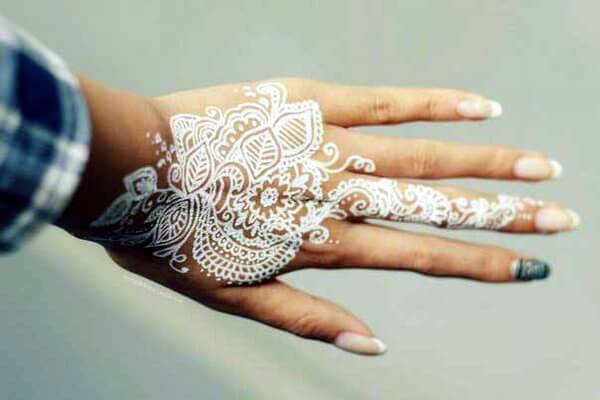

Moreover, special attention is paid to the meaning of the applied image. What henna tattoos on the hand are popular today? Let's allocate 4 of them.
- Patterns. Means good luck on a personal front, love or a romantic relationship.
- The lotus. The flower of this beautiful plant is applied by those who need good luck in affairs.
- Owl. A symbol of wisdom, it indicates the mental qualities of its wearer.
- Dreamcatcher. It is believed to protect from evil spirits and protects from spoilage and the evil eye.
Especially stylish looks mehendi white henna, such ornaments often attract girls and young ladies. Today, making drawings of white henna on the arm for girls is very fashionable, it symbolizes purity, so such patterns are often used by brides.
Types and recipes of pastes
Depending on what henna is used in the preparation process, pastes are divided into ready-made formulations and pastes with natural henna. Ready-made paste is more suitable for those who draw professionally and master the mehendi technique. In this case, the advantages of ready-made compositions are that they:
- provide a quick manifestation of the drawing on the body - immediately after its application;
- allow you to create a drawing equally bright on different parts of the skin;
- Save your time.
However, ready-made pastes are not without disadvantages, in particular:
- after application, the pattern cannot be corrected;
- Patterns remain on the skin no longer than 7 days.
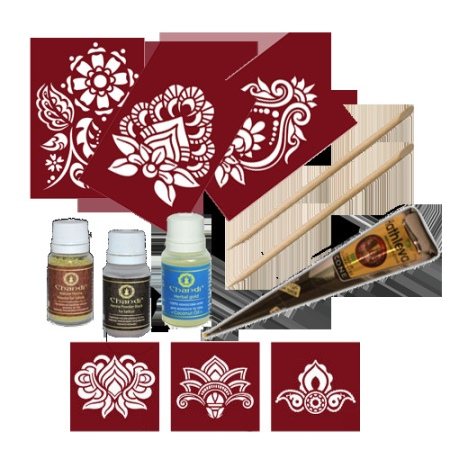

Beginners are more convenient to work with natural paste. It is easy to prepare it at home. The advantages of self-cooked composition are that:
- the pattern will appear after a few hours, and the details of the pattern can be changed if you are not very happy with them;
- The pattern will stay on the body for more than 20 days;
- self-made pastes are cheaper.
The only disadvantage of pastes with natural henna is that the pattern will be unequal in intensity on smooth and keratinized areas of the skin. In the latter case (on the palms and feet) the color will be brighter. For the pattern to be easily applied and to last longer, the quality of raw materials must be high. Henna for hair coloring, which is sold in stores, is not always suitable for mehendi. The fact is that the powder must be very fine. One simple way out of this situation is to grind henna in a coffee grinder so that it becomes similar to fine dust.
There are several known recipes for making pasta at home, the shelf life of which varies depending on the ingredients included.
Recipe based on tea
This composition can be kept in the refrigerator for 2 days. It includes:
- half a cup of strong freshly brewed tea;
- The juice of half a lemon;
- 6 tsp. sugar;
- 8 tsp. henna.
In a ceramic bowl, mix the brew and lemon juice. Add sugar, henna, stir well until smooth. After 20 minutes the paste is ready.
To prepare this paste you need to take:
- instant coffee (5 tsp;)
- warm water (1 tbsp.);
- 2 regular packs of henna;
- Eucalyptus oil (5 drops);
- clove oil (5 drops).
Dissolved in water, we put the coffee on the fire and evaporate by one-third. Add henna, oils. The paste should insist for 2-3 hours and used immediately after this time.
In half a glass of chifir (strong thick tea) we add:
- 2 regular packets of henna;
- The juice of half a lemon;
- any vegetable oil (2 drops).
The mixture should be stirred thoroughly, leaving no lumps. The paste must stand for 5 hours. This amount of paste should be enough for 2-3 drawings.
Tools and materials for work
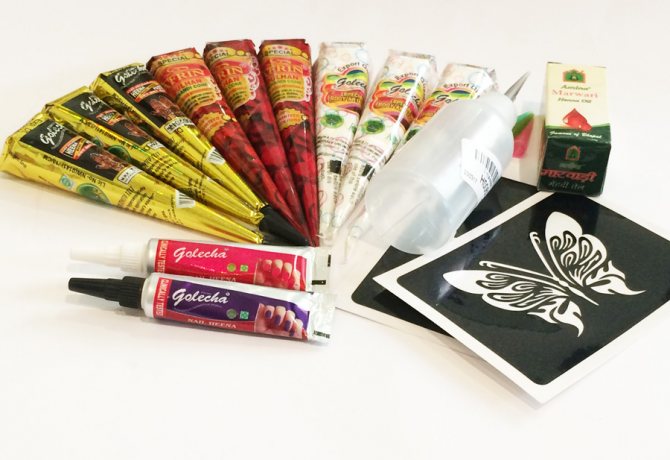

To create the first drawing you will need to prepare a set of paints and tools for its application. The easiest solution is to buy a ready-made mehendi kit. However, such set often costs a lot (from 1 600 rubles) and does not always contain what you need. It is much cheaper to buy components separately. Let us dwell in detail on each component of the arsenal of the master of mendi.
Recipes for homemade mehendi paste
Mehendi on the hand (for beginners, it is recommended to use the paint on which the training took place) can be performed not only with store-bought paste, but also with that which was prepared at home.
Proven recipes for creating henna for tattoos are:
| The classic recipe | Recipe for a richer color |
|
|
Mehendi painting for men
Men also like to decorate their bodies with original patterns and make mehendi at home. And if it's easy to choose a drawing for boys, it's not so easy for a guy to find a suitable ornament.
Men's henna drawings should not be floral and sentimental - these are female options. For example, if you need to draw a henna sleeve, it is better to choose an abstract composition with clear lines.


It is the hands most often choose men to do the henna tattoo. Less often - legs, back, shoulders and forearms. Also the stronger sex prefers to avoid small patterns, rightly believing that the male tattoo should be large.
Where to get a henna tattoo?
Before you sign up for a master, we recommend deciding on the location of the temporary tattoo. So it will be much easier to pick up a drawing from the proposed catalog.
Tattoo on hands
Most often as a zone for the application of henna tattoo girls choose the hands. And not only on the outer side, but also on the palms. As for the drawing itself, the animalistic genre looks very beautiful: unusual birds, insects and various animals. Such a solution is suitable for lovers of wildlife and those who are engaged in self-discovery.


Quite often, as tattoos, drawings with plant themes are applied. Beautiful flowers, small leaves and climbing vines give the hands a special elegance. By the way girls note that with such patterns their movements become smooth and graceful.
Lace, openwork patterns are also popular. It is this option is chosen for large tattoos, as well as for themed photo shoots.
It is impossible not to note that tattoos on the hands, made by henna, do not hold too long. This is due to the frequent exposure to water. Therefore, do not expect that the drawing will last longer than a week.
The henna tattoo on legs
Unlike the previous variant, on legs the henna drawing is applied not often. According to the masters, this is due to the fact that part of the drawing is erased by shoes. Also, many girls do not understand what image should be made to go well with mehendi.
However, if you like such options, then do not rush to give up on this idea. After all, if you want, you can make concise patterns that will become a decoration for the legs.


You can afford more voluminous options on vacation. Believe me, they will be pertinent at sea.
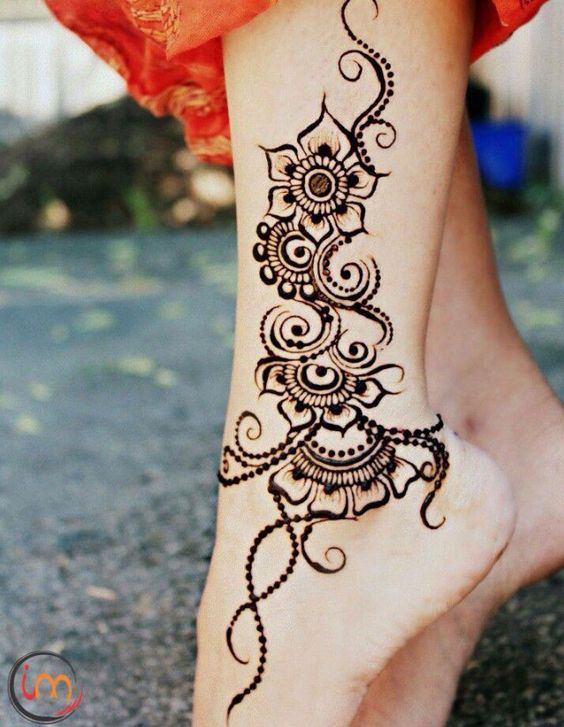

And some girls and do tattoo almost on the hip. Therefore, this picture will be visible only if you wear short shorts.
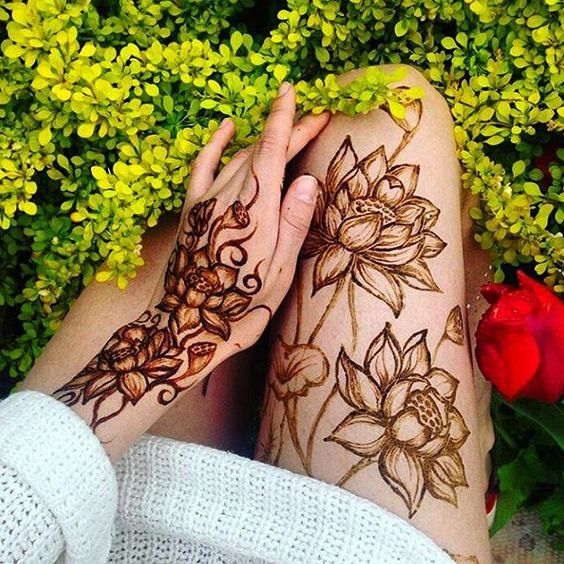

Tattoo on the body
To make a neat, beautiful drawing, which will emphasize the refinement and a good figure can every girl. Depending on the place where the henna tattoo is planned, you need to choose a suitable shape pattern.


Perhaps it is on the back that the most varied patterns can be found. Some are quite miniature, others look three-dimensional, and some even resemble a work of art. And each of these options looks great.
Depending on your preference, you can choose simple lines, an intertwining of branches, a gorgeous flower, or a symbol that has special meaning to you. Each image is capable in its own way to emphasize the beauty or complement the image. So try to choose only what inspires you and gives you confidence.
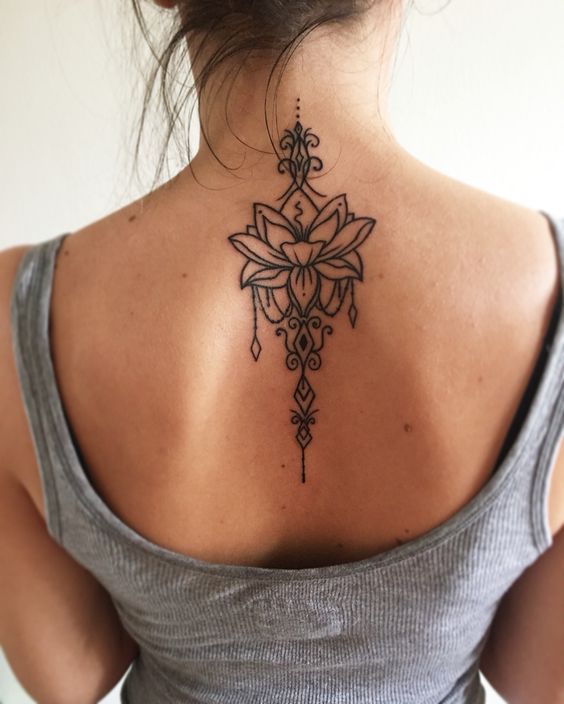

No less beautiful look tattoos on the shoulder or forearm. Often in this place are applied symbols that have a special meaning for a person. Also, quite often girls choose a beautiful flower.
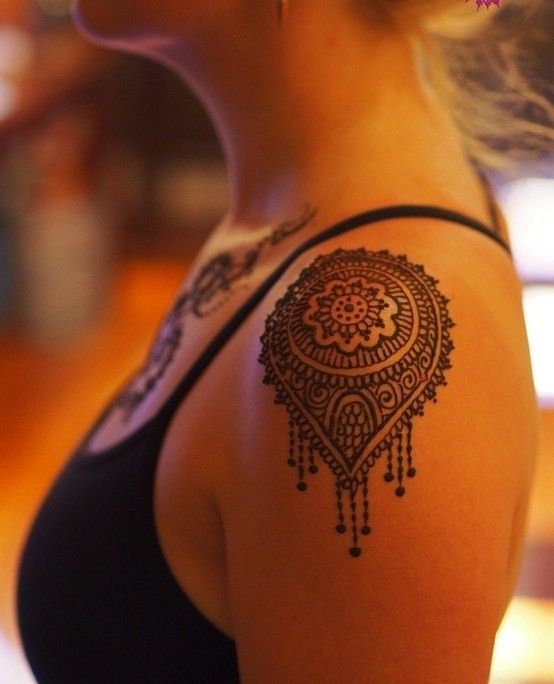

On the neck, stomach and chest henna tattoos do not do so often. But if you choose a suitable drawing, it will look really worthy. If you are ready for such experiments, be sure to try to choose something unusual to apply to any of these areas.


Applying a henna pattern
Before preparing the skin, it is important to puzzle over and how to properly make mehendi at home yourself. If you are a skilled artist with properly grown hands, then the process of drawing will not be very difficult for you. But what to do if you can draw, but you are afraid that at the crucial moment the hand will shake?
There is a way out: after preparing your skin for biotatu, draw the desired pattern on it with a cosmetic pencil (eyebrow pencil, eye pencil, lip pencil, but not waterproof) or with a water-based marker (as you understand, a permanent marker will do nothing unless you have absolutely no henna *rofl* ). This way you can move confidently along the drawing, excluding mistakes, blots and other nuisances.
What if you can't draw at all? No, do not despair: there is a way out for you too, and you just like everyone else can flaunt boho style. Or any other style. Just for you, there are detailed videos on how to paint henna on your arm, leg, and wherever you want. Or the wonder of invention: stencils. You can buy them in the salons of mehendi-masters, on specialized websites, the same Indian exhibitions or even make your own (though, it is quite time consuming and requires a certain skill).
Here are a few step by step video instructions:
The stencil can be attached to the skin with adhesive tape or scotch tape. Avoid "trapping" the stencil in the folds of the skin: the design will spread and lose its shape. Also take care not to accumulate too much paint on the borders of the stencil, because "too much" can disrupt the pattern, the smoothness of the lines and their thickness. If this happens, quickly erase the defect with a cotton swab or thin match. The pattern is laid out in a couple of millimeters thick (2-3).
In this way, it is thinner and more delicate. However, if you apply thicker, the durability and intensity of the pattern increases many times over. Here already decide what is more important to you: the elegance of the lines or the longevity of the picture.
Tattoo henna at home
In case you have not found the master on the application of such tattoos, you can do it yourself. Of course it will require a little practice so that the drawings were even and of the same thickness. It is also necessary to buy some materials for the work.


It is best to buy a ready-made composition for the application of drawings. It can be in a tube or in a special cone. The latter option is the most convenient, because the henna from the cone acts evenly. For beginners, this is an ideal option that will help you quickly learn how to make beautiful patterns.
If you have trouble finding a ready-made mixture, you can make it yourself. There are several recipes that differ from each other by additional ingredients. This does not affect the quality of henna, so choose any of them.


According to the first recipe, you need to mix about 20 grams of henna and the juice of half a lemon. This mixture should be insisted in a bag for one day. After that, you can add essential oil to make the pattern last longer, as well as ground coffee to make the mixture darker.
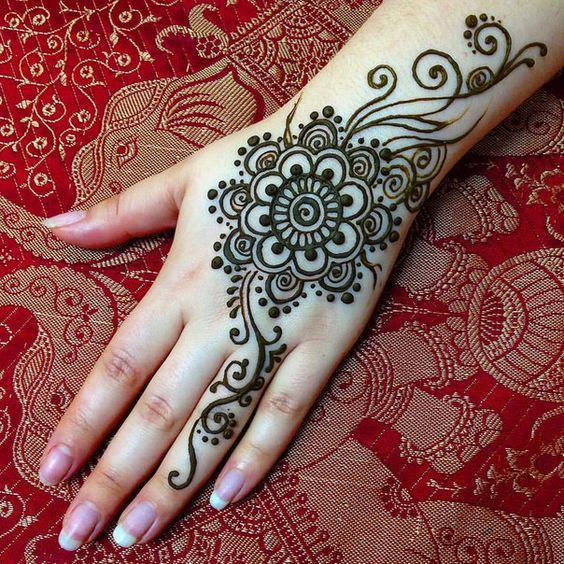

The second recipe is that the same amount of henna should be boiled in water for an hour. You can add black tea or coffee to brighten the color. The mixture should be cooled and only then try to apply drawings.
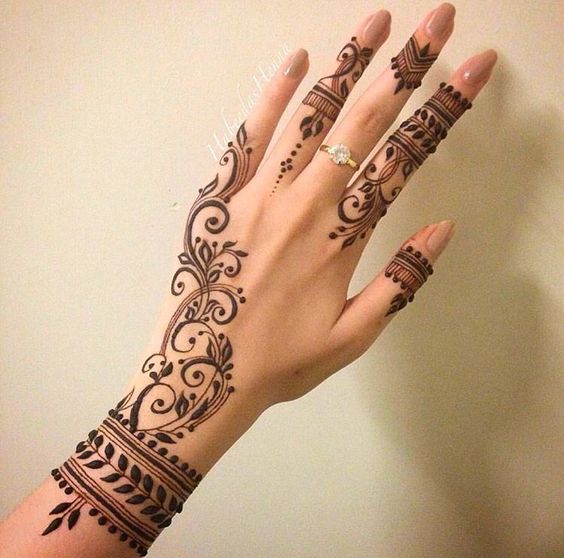

As for the process of application, some masters suggest that beginners use special stencils. Thanks to this, the drawing will definitely have the right shape.
A beautiful henna tattoo is a whole art, thanks to which you can decorate the body and emphasize its merits. In addition, the process of drawing is absolutely painless, which is a significant advantage.
Have you tried a henna tattoo?
List of sources
- salon-nagorkogo.ru
- ratatum.com
- princessovna.ru
- lifegirl.ru
- costmart.ru
- wlooks.ru
Is it safe?
Many people consider henna painting as something quite safe and not harmful to health. Because mehendi on the hands is applied without damaging the skin, there is indeed no risk of infection or capillary injury. But there is a risk of allergic reactions. You should be wary of the appearance of allergic swelling when applying biotattoos yourself or when using the services of masters of dubious qualifications.
The thing is that cheap low-quality paints for applying mehendi on hands often contain not only natural pigment derived from lavsonia leaves, but also auxiliary substances that are not safe for skin. These include the artificial dye para-Phenyldiamine (PFDA), as well as other synthetic dyes and base components. They provide bright color and durability, but can cause severe allergies.
Severe allergic reactions can lead to rough scars that do not disappear for many years.
In order not to suffer from the use of low-quality paints, remember a few safety rules:
- When buying paint, don't chase the cheapness. Study the composition, make sure there are no synthetic components, study customer reviews.
- Before using the paint (even if you are absolutely sure of its quality), do an allergy safety test. Apply a little paint on the back side of the palm. If in 15-30 minutes there is no itching and redness, you are not allergic to the components of the paint.
- Do not use the services of artists in whose professionalism you doubt: street painters, working at home masters who are not qualified.
If you follow these rules, mehendi on your hands is completely safe. Such a procedure is permissible even for pregnant women.
Sketches for guys
Guys love to decorate their palms, wrists, shoulders or neck with interesting and intricate designs.
Popular male patterns include:
- Latin inscriptions;
- Hieroglyphics;
- dragons;
- snakes;
- wolves;
- lions;
- dream catchers, in the center of which there are animal charms (e.g. owl, wolf, scorpion, spider).
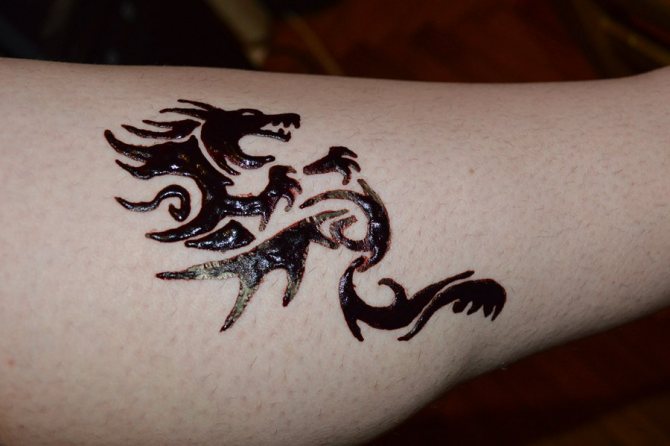

Owners of mehendi with a dragon demonstrate inner harmony.
Men often choose images of animals with which they identify themselves, as well as intricate patterns similar to ancient symbols.
Spiral
Mehendi: UGC.
A variety of spirals are easy drawings in mehendi. More often than not, they form the basis of a composition. The spiral itself is an image of infinity.
The spiral itself is a prototype of infinity. It is a symbol of the infinity, which means the thirst for self-discovery, which is experienced by the person. He wants to know his inner world and for this he makes a difficult journey inside himself along the spiral.
The spiral signifies the infinity of the world and its cognition. It also signifies the "kundalini," the energy sleeping in each person, which, when awakened, connects with the universe.
This pattern is suitable for those who are at a crossroads in life, who have to make an important choice, who are looking for yourself.
Stencils for henna tattoos
Choose the design you want and stick it to the skin with an ordinary plaster. And on top of the stencil apply the paste, gradually filling all the voids. Then wait until the paste dries a little and the stencil can be removed.
You can also make a stencil yourself. Indian women use an ordinary plaster for this purpose. The easiest option is from self-adhesive film.
You cut out the image you want and stick it on the skin. The stencil has to be glued tightly to the skin and make sure that nothing extra gets under the stencil.
Henna drawings on the hand
How a quality work should look like
Painting with natural henna will last from 1 to 3 weeks, but the final shade it will take a while.
The manifestation of color occurs in stages:
- Immediately after the work is completed, the pattern becomes a dark brown.
- Four to 12 hours after the paste is removed, it lightens to a bright orange hue.
- After another 24-48 hours, the mehendi becomes a red-brown color.
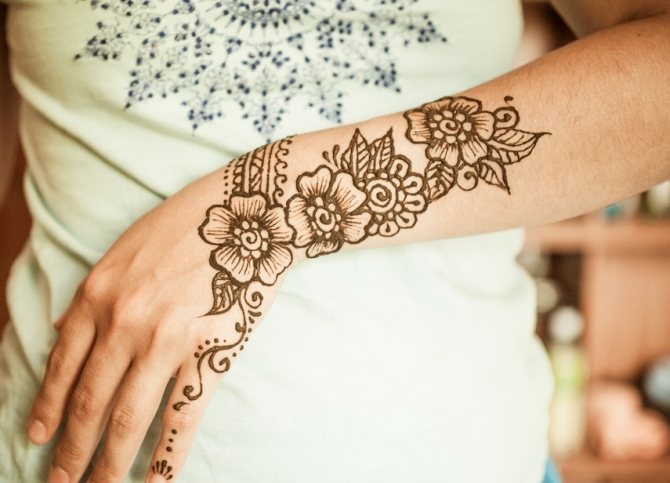

Mehendi allows you to create exquisite patterns, to decorate your body.
All lines of quality work always have smooth transitions and are harmonious with each other, and images are proportional and identical to the sketch.
Patterns on the palm
Now we move with you to the more interesting part - the patterns on the palm. The palm gives a wide scope for creative expression. Patterns on this part usually consist of an abstract design that comes from the center.
In order to draw a pattern correctly, you need to pinpoint the center of the palm (or choose a point close enough to the center ). Patterns on the palm start with a point, a circle, a spiral, a flower, a star.
You may be interested in: History of Christmas decorations
In short, you can use any symbol or image you like best. Then keep adding elements that come from that center point.
This is one of the easiest ways to create patterns that will look great on your palm!
Another idea for decorating your palm is to draw something that is closely related to you or personally symbolizes you. It can be a special flower, a bird, a favorite pet or wild animal, or any object that describes you. Anyway, you don't have to worry about making it look realistic, because henna drawings are abstract, so anyone can learn to draw them, both adults and children. All that is required from you is a desire and a flight of creative thought!
